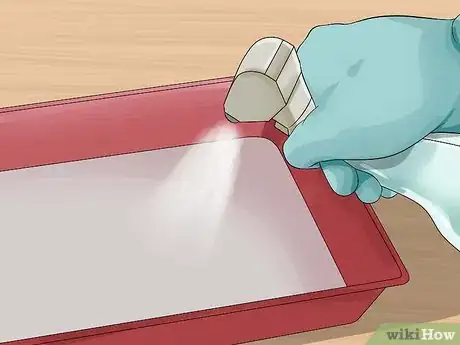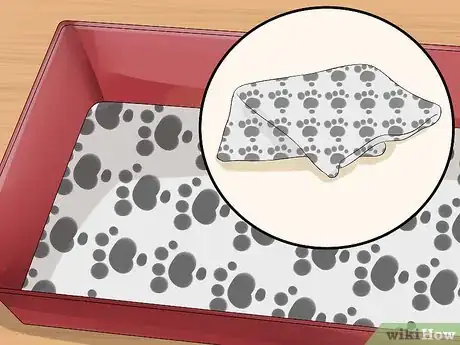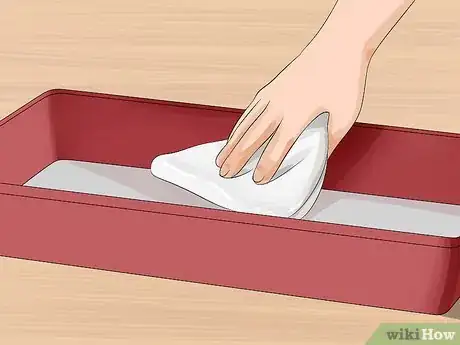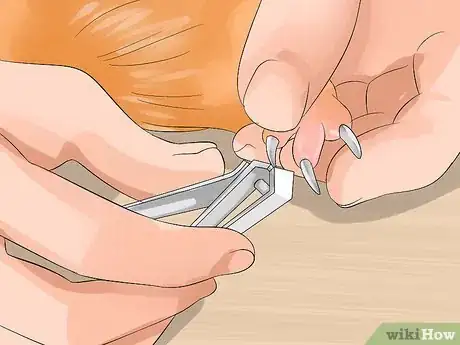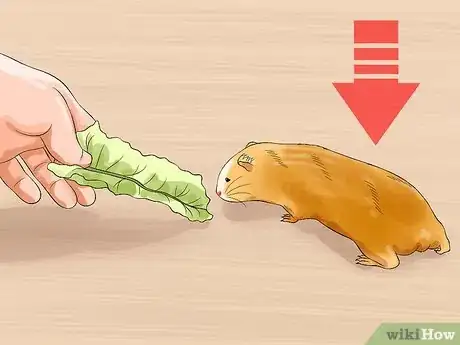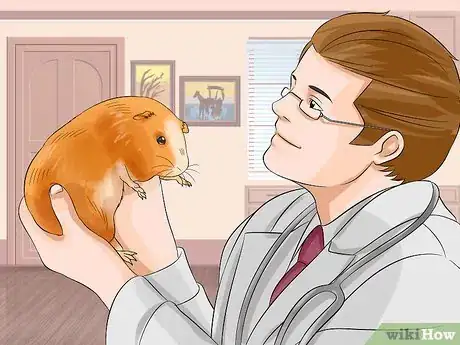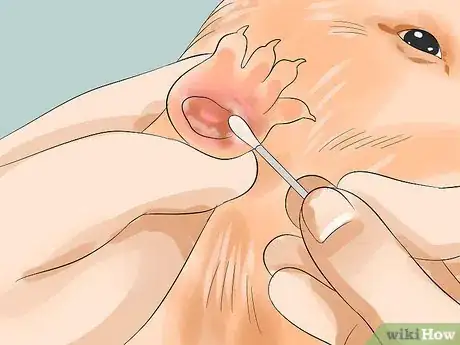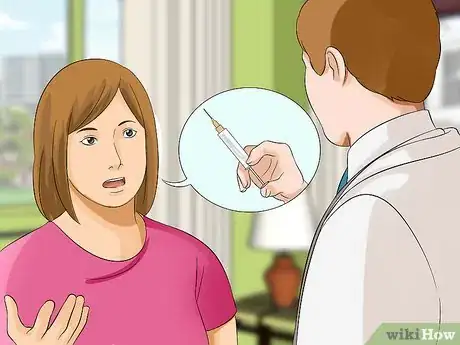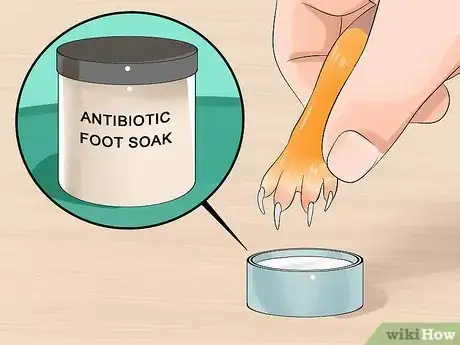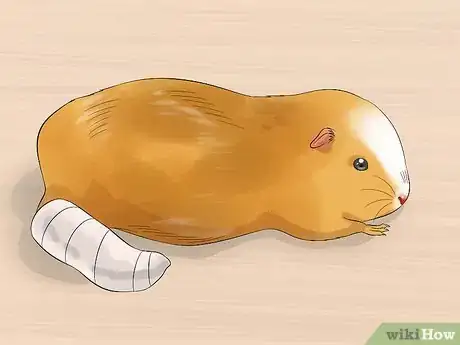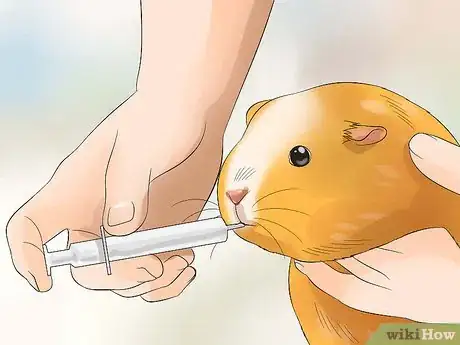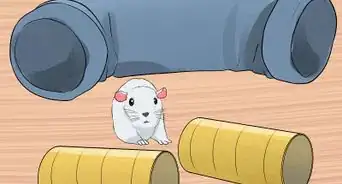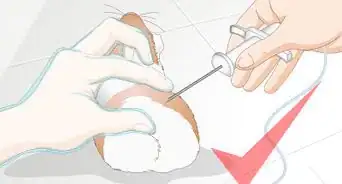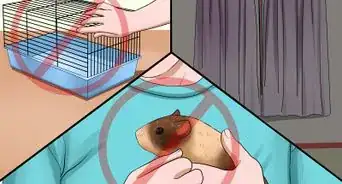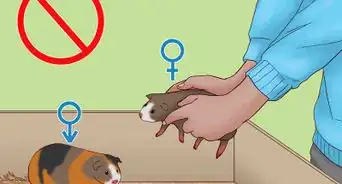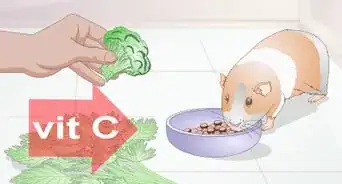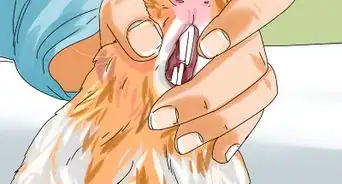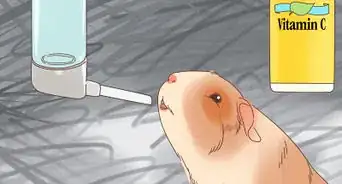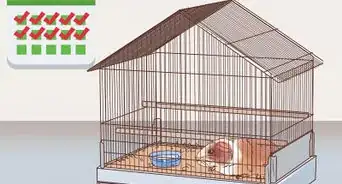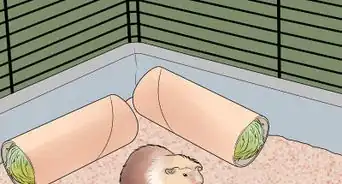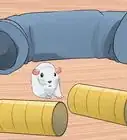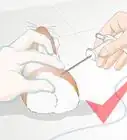This article was co-authored by Pippa Elliott, MRCVS. Dr. Elliott, BVMS, MRCVS is a veterinarian with over 30 years of experience in veterinary surgery and companion animal practice. She graduated from the University of Glasgow in 1987 with a degree in veterinary medicine and surgery. She has worked at the same animal clinic in her hometown for over 20 years.
There are 14 references cited in this article, which can be found at the bottom of the page.
wikiHow marks an article as reader-approved once it receives enough positive feedback. In this case, 91% of readers who voted found the article helpful, earning it our reader-approved status.
This article has been viewed 142,658 times.
Bumblefoot (pododermatitis) is a potentially fatal ulceration and infection of a guinea pig's feet and/or toes. It can be caused by any number of factors, including the guinea pig being overweight, untrimmed nails, poor sanitation, or wire cage floors. Once your guinea pig gets it, you should see your vet. However, you can take a few steps to manage it at home, too.
Steps
Treating Bumblefoot Through Cage Management
-
1Create a smooth floor. Because rough floors can lead to sores, creating a smoother floor can help your guinea pig get over bumblefoot. Wire-cage floors, plastic floors that have pieces jutting up, and other rough floors are all harmful to your guinea pig's feet. Wire-cage floors are the biggest culprit.[1]
- A solid floor works best. You can look for a new cage that has an appropriate floor or try to find an insert for the cage that you have.
- Canvas, plastic, or even coated metal are all appropriate choices for a solid floor. You should be able to find an insert specifically designed for your guinea pig's cage.
- Hard, smooth floors can still chafe, so provide some deep, soft bedding to make it more comfortable for your guinea pig.
-
2Clean the cage more often. Increased bacteria can lead to more infection. Therefore, cleaning the cage more often can help decrease your guinea pig's chances of getting bumblefoot, as well as help with recovery if your pet already has it.[2] Try to clean out the cage at least once a week.[3] You may want to move outside to really clean out the cage.
- Take the guinea pigs out, and bag up the old bedding. Have a disinfectant ready that's safe for small animals.[4] You can find these disinfectants at pet stores. Alternatively, you can use a mixture of white vinegar and water (half and half).[5]
- Wash thoroughly with soap and water. You can use dish soap for this purpose, but you should probably keep a dedicated bottle. You can soak any hard spots in vinegar and scrub them with a toothbrush.[6]
- Disinfect. Spray the disinfectant on, being sure to get the whole cage. You can leave it on to help it do its work.[7] Rinse it clean when it's done, making sure to remove all the disinfectant.
- Once a month, use very diluted bleach as a disinfectant (one part bleach twenty parts of water).[8] Make sure to always rinse the cage thoroughly to make sure you don't leave traces of the bleach.
Advertisement -
3Choose a softer bedding. Hard floors can lead to pressure sores, so it's important to provide deep, soft bedding for your guinea pig. One possible choice is VetBed.
- Sometimes, the guinea pig won't want to use the softer bedding, which is why you can just put it in part of the cage at first to see if your guinea pig likes it.
- Try to layer it slightly thicker than you normally do.
-
4Keep the floor dry. If the bedding gets wet, it keeps the guinea pig's feet wet. In turn, their feet remain softer, which can cause the feet to crack. Cracked feet open the door for more infection.[9]
- Try changing the bedding more often, especially where the guinea pig uses the restroom and under the water bowl or bottle.
- Once a day, check for wet spots. Scoop the wet spot out, wipe underneath it with a paper towel, and then add dry bedding back in.[10]
Treating Bumblefoot Through At-Home Treatments
-
1Trim the pig's nails. While you should be trimming the nails at least once a month anyway, doing so while the guinea pig has bumblefoot is especially important. Long nails can sometimes be a cause of bumblefoot.
- You can use human nail clippers for this process, though you should dedicate a pair to your pet. You can also use the guillotine type meant for pets. However, since those are meant for cats and dogs, human nail clippers can sometimes be easier to use on guinea pigs.[11]
- Have someone hold the guinea pig while you trim to make it easier. If you don't have another person around, you can distract the guinea pig with a carrot or some other treat while you trim the nails.[12]
- Another option is to hold the guinea pig up against your chest with its stomach facing out. Have one hand under the stomach, while also using that hand to immobilize one paw at a time.
- Trim up and down, as opposed to side to side. Look for the quick first, which brings blood to the nail. You should be able to see it easily if the guinea pig's nails are light-colored. If they're dark, have someone shine a light through them. Make sure not to get the quick. If you do make the guinea pig bleed, use a styptic pencil on it to stop the bleeding.[13] You can also use cornstarch, flour, or talc to stop the bleeding.
-
2Increase vitamin C. Sometimes, guinea pigs don't get enough vitamin C in their diet. In turn, their bodies won't produce enough collagen, which can increase problems with bumblefoot. Adding more vitamin C to the diet can help solve the problem.[14]
- Check your guinea pig food. It should be providing at least 10 milligrams of vitamin C per day.[15]
- Supplement with fresh fruits and vegetables. You can add some fresh vegetables to your guinea pig's diet, including greens like turnip greens, parsley, and kale, as well as other vegetables such as green peppers, broccoli, and cabbage. You can also use fruit high in vitamin C, such as oranges or strawberries.[16]
- When your guinea pig is deficient, you can feed it quartered tablets of chewable, flavored vitamin C. Choose the 100 milligram option, which when quartered would equal 25 milligram tablets. You can give these quartered tablets twice a day for a week.[17]
-
3Put your guinea pig on a diet. Being overweight can cause or worsen bumblefoot. If your guinea pig is overweight, decrease its food a little bit. Reducing the calories your guinea pig eats should help it lose weight.[18]
-
4Consider some at-home soaks. Some people swear by soaking the guinea pig's feet in solutions to help with the bumblefoot. You need to supervise the guinea pig while it is in a soak, as it can get the medication in its eye. Ask your vet about a protective eye cream.[19]
- To soak a foot, put the solution in a small cap, and hold the guinea pig, with the foot in the soak.[20]
- Try a solution of a half a cup of warm water and a 1/8 teaspoon of epsom salt. Use a small portion of it in a cap a couple of times a day, up to three times.in a day.[21]
- Try Betadine, a povidone-iodine solution. You can get this at your vet, and she will tell you how much you need to dilute it for your animal.
Visiting the Veterinarian
-
1Take your guinea pig to the vet. Your vet can best diagnose this condition. Also, she can help you decide on the best course of treatment.[22]
- Pick a vet knowledgeable in small animals like guinea pigs.
-
2
-
3Ask your vet about antibiotic treatments. Your veterinarian may do one of several treatments. For instance, she may flush the sores with an antibiotic solution. She may also inject antibiotics into the infected site.
- She might also use an anti-inflammatory medication with the antibiotics.
-
4Use antibiotic foot soaks. Another common solution is to use foot soaks that contain antibiotics. While your vet knows best, generally you use a small container like a pill bottle lid to soak your guinea pig's foot in the solution several times a day.[25]
- Always supervise your guinea pig while its foot is soaking to ensure proper treatment, as well as to make sure the guinea pig doesn't get it in its eyes or mouth.
- Make sure to ask your vet for tips about foot soaking.
-
5Apply topical antibiotics and bandages. You may need to apply antibiotics, much like applying an antibiotic ointment to a cut you have. Your vet can show you the best way to do it.[26]
- Keep in mind that your guinea pig shouldn't ingest these creams. Therefore, you want to use as little as possible, while still covering the wound. Wipe off any excess.[27]
- She may also recommend bandaging your guinea pig's paws to help with recovery. Make sure she shows you how to do it before you leave.[28]
-
6Give any oral antibiotics or pain medications.. Your guinea pig may need oral antibiotics, as well as pain medications. Usually, you'll only get these medications if the bumblefoot is particularly bad or advanced.[29] You may also get a probiotic treatment to go with the antibiotic. The easiest way to give oral medication is using a syringe to give liquid medications. However, giving oral medications is never easy.
- Try holding the guinea pig in your lap, wrapping your hand around its stomach. You need to grip the guinea's jaw with your hand, and you will need to grip it pretty hard. Your hand should be below the eyes.[30]
- Push the syringe around the front teeth. You'll need to go in from the side of the mouth. Keep working it into the mouth.[31]
- You'll know when to stop because the guinea will start chewing on the syringe. At that point, you can depress the syringe, releasing the contents slowly, watching to make sure the guinea is still chewing. If it's not, move the syringe a bit to get it chewing again. Having the guinea pig chew is important because it shows it is swallowing.[32]
- You can also use this same technique with a pill. However, instead of a syringe, use a hemostat, which is readily available at medical supply stores. Place the pill in the hemostat, then use it to get the pill in the back of the throat, much as you inserted the syringe.[33]
-
7Understand the final treatment. If bumblefoot gets too bad, your vet may recommend amputating the leg. While the treatment is extreme, it could save your guinea pig's life.[34]
Expert Q&A
Did you know you can get expert answers for this article?
Unlock expert answers by supporting wikiHow
-
QuestionDoes a guinea pig with bumble foot need to be separated from one without it?
 Pippa Elliott, MRCVSDr. Elliott, BVMS, MRCVS is a veterinarian with over 30 years of experience in veterinary surgery and companion animal practice. She graduated from the University of Glasgow in 1987 with a degree in veterinary medicine and surgery. She has worked at the same animal clinic in her hometown for over 20 years.
Pippa Elliott, MRCVSDr. Elliott, BVMS, MRCVS is a veterinarian with over 30 years of experience in veterinary surgery and companion animal practice. She graduated from the University of Glasgow in 1987 with a degree in veterinary medicine and surgery. She has worked at the same animal clinic in her hometown for over 20 years.
Veterinarian
-
QuestionHow can I tell if my guinea pig is overweight?
 Pippa Elliott, MRCVSDr. Elliott, BVMS, MRCVS is a veterinarian with over 30 years of experience in veterinary surgery and companion animal practice. She graduated from the University of Glasgow in 1987 with a degree in veterinary medicine and surgery. She has worked at the same animal clinic in her hometown for over 20 years.
Pippa Elliott, MRCVSDr. Elliott, BVMS, MRCVS is a veterinarian with over 30 years of experience in veterinary surgery and companion animal practice. She graduated from the University of Glasgow in 1987 with a degree in veterinary medicine and surgery. She has worked at the same animal clinic in her hometown for over 20 years.
Veterinarian A rough guide is how much it weighs, with an average being 0.7 - 1.2 kg. However, a small guinea pig that weighs 1.2kg is likely to be too heavy, because of its small frame. The guinea pig should look sleek and glossy, but without rolls of fat or a dewlap. You should be able to feel its ribs when you apply gentle pressure, and be able to easily identify where the rib cage ends and the belly begins.
A rough guide is how much it weighs, with an average being 0.7 - 1.2 kg. However, a small guinea pig that weighs 1.2kg is likely to be too heavy, because of its small frame. The guinea pig should look sleek and glossy, but without rolls of fat or a dewlap. You should be able to feel its ribs when you apply gentle pressure, and be able to easily identify where the rib cage ends and the belly begins.
References
- ↑ http://www.peteducation.com/article.cfm?c=18+1800&aid=3066
- ↑ http://www.peteducation.com/article.cfm?c=18+1800&aid=3066
- ↑ http://jackiesguineapiggies.com/cagecleaning.html
- ↑ http://jackiesguineapiggies.com/cagecleaning.html
- ↑ https://www.guineapigcages.com/cleaning.htm
- ↑ http://www.guinealynx.info/housing_tips.html
- ↑ http://jackiesguineapiggies.com/cagecleaning.html
- ↑ http://www.guinealynx.info/housing_tips.html
- ↑ http://www.petmd.com/exotic/conditions/skin/c_ex_gp_pododermatitis?page=2
- ↑ http://jackiesguineapiggies.com/cagecleaning.html
- ↑ http://www.guinealynx.info/nails.html
- ↑ http://www.guinealynx.info/nails.html
- ↑ http://www.guinealynx.info/nails.html
- ↑ http://www.merckvetmanual.com/pethealth/exotic_pets/guinea_pigs/disorders_and_diseases_of_guinea_pigs.html
- ↑ http://www.merckvetmanual.com/pethealth/exotic_pets/guinea_pigs/disorders_and_diseases_of_guinea_pigs.html
- ↑ http://www.merckvetmanual.com/pethealth/exotic_pets/guinea_pigs/disorders_and_diseases_of_guinea_pigs.html
- ↑ http://www.guinealynx.info/scurvy.html
- ↑ http://www.peteducation.com/article.cfm?c=18+1800&aid=3066
- ↑ http://www.guinealynx.info/pododermatitis.html
- ↑ http://www.guinealynx.info/pododermatitis.html
- ↑ http://www.guinealynx.info/pododermatitis.html
- ↑ http://www.guinealynx.info/pododermatitis.html
- ↑ http://www.merckvetmanual.com/pethealth/exotic_pets/guinea_pigs/disorders_and_diseases_of_guinea_pigs.html
- ↑ http://www.merckvetmanual.com/pethealth/exotic_pets/guinea_pigs/disorders_and_diseases_of_guinea_pigs.html
- ↑ http://www.petmd.com/exotic/conditions/skin/c_ex_gp_pododermatitis?page=2
- ↑ http://www.petmd.com/exotic/conditions/skin/c_ex_gp_pododermatitis?page=2
- ↑ http://www.guinealynx.info/supplies.html
- ↑ http://www.guinealynx.info/pododermatitis.html
- ↑ http://www.petmd.com/exotic/conditions/skin/c_ex_gp_pododermatitis?page=2
- ↑ http://www.guinealynx.info/tips.html
- ↑ http://www.guinealynx.info/tips.html
- ↑ http://www.guinealynx.info/tips.html
- ↑ http://www.guinealynx.info/tips.html
- ↑ http://www.petmd.com/exotic/conditions/skin/c_ex_gp_pododermatitis?page=2
About This Article
To treat bumblefoot in guinea pigs, cover the bottom of the cage with a smooth, solid floor made of canvas, plastic, or coated metal. Next, replace its bedding with something softer and be sure to keep the cage clean and dry. Then, increase the amount of vitamin C in your pet's diet by adding a supplement and feeding it more fresh fruit and veggies. You can also try soaking its feet in a solution of warm water and Epsom salt. For tips on other at-home foot soaks you can try, read on!

